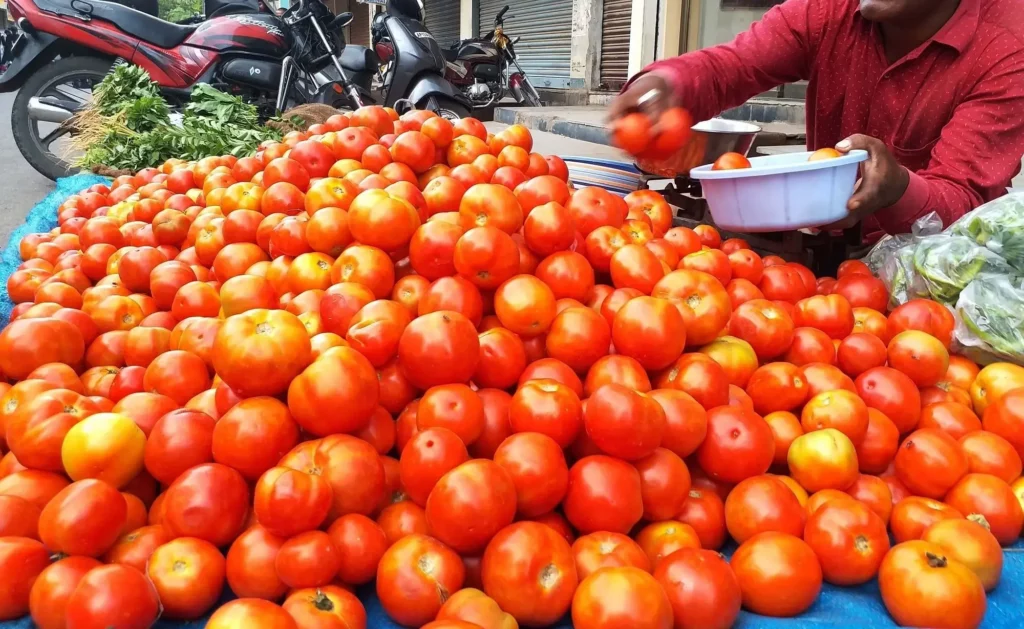As a result of high demand and limited supply in the market, tomato prices have now hit the century mark. This is due to the market situation. A decrease in crop output has also been recorded, which has led to an increase in the price of other types of vegetables. The result of this is that the price on the market has gone up.

On Tuesday, the upward trajectory of vegetable prices in Karnataka continued its ascent into the stratosphere. It is possible that the delay in the onset of the monsoon this year is the cause of the price increase. Since last week, the price of tomato has increased to Rs 100 (per kg) since there is a shortage of supply, which has led to a jump in the price of many other vegetables as well.
You might be familiar with the Tomatina festival that takes place in Spain. The film “Zindagi Na Milegi Dobara” featured it in one of its scenes. Because of the price increase, if the festival were held in Karnataka, people might have hurled stones at each other instead of tomatoes because of the competition for limited supplies.
According to sources, the price of a tomato in the market at the moment is greater than 100 rupees.
People are seeing red as a result of the unexpected increase in the price of tomatoes. According to reports, the price increase can be attributed to the scarcity in supplies. On Sunday, a crate of tomatoes weighing 15 kilogrammes was going for an astounding one thousand and one hundred rupees in the Kolar APMC. It is clear that the price is far higher in the Bengaluru market because the traders pick them up at a higher price, which indicates that the price is significantly greater.
When compared to the prior years, the planting of tomatoes has not been quite as extensive this year. On the other hand, because the monsoon arrived later than expected, there has been a shortage of even those little quantities of tomatoes on the market. Because of this, costs have skyrocketed.
It used to be that the Bengaluru marketplaces of Kalasipalya and Dasanpura received over 60,000 crates of 12 kg each per week; however, this number has decreased to only 30–35 thousand boxes. Cities such as Tumkur, Ramanagara, and Chennapatna, which are known for their tomato production, have experienced hailstorms. As a result, the crops have produced significantly less fruit. Even in Kolar, supplies have decreased, and the price each 15-kilogram box has increased to between 800 and 900 dollars, from a previous range of 200 to 300.
“Despite the fact that the monsoon has not yet arrived in Karnataka, this year’s temperatures have been significantly higher than normal. In addition to this, the veggies have lost their moisture, and the tomato has developed a disease called “white fly disease.” According to C Murali, a merchant from Kolar, the crop has witnessed a yield that is fifty percent lower than normal.
Increases in cost for all other types of vegetables
In addition to tomatoes, a wide variety of other vegetables are also being offered for sale at far higher prices than is customary. In the event that this problem persists, we might be forced to use our debit cards to pay for the vegetables. The cost of beans per kilogramme is around 140. There are now more than a hundred different varieties of carrots.
According to the sources, each egg may be purchased for 8 Indian Rupees. The price of Knol Khol has been raised by 70 rupees, and the price of Okra has gone up by 60 rupees per kilogramme.
The summer saw an above-average amount of precipitation in the regions surrounding Bengaluru that are used for vegetable production. These regions include Chikkaballapur and Doddaballapur. As a result of the fact that the monsoon season has not started in Karnataka just yet, the majority of the plant and vegetable crops have seen a loss of production as a direct result of either excessive rainfall or no rainfall at all. Although there is a great demand for veggies in the market, there is a limited supply.
Even at this price, the farmers would not receive the amount that is rightfully theirs due to the fact that the middlemen are the ones who make a significant amount of money by moving the veggies from one market to another.
As a consequence of this, the eateries might decide to raise the pricing of the food they offer. In the event that the price of vegetables continues to grow, the market will expand, and the intermediaries will make more money. The average person will be forced to bear the burden of the fluctuating prices.
Tomatoes, which were 10 rupees per kilogramme in Bhopal one week ago, are now reportedly selling for 100 rupees per kilogramme, as reported by the Free Press Journal.